Réthymnon (GR: Ρέθυμνον) is the capital of the Prefecture of the same name and it is built between two other large cities of Crete.
In the east is
Iraklion (80 km) and to the west is
Hania (60 km).
It lies along the north coast, having to the east one of the largest sand beaches in Crete (12 km) and to the west a rocky coastline that ends up to another large sand beach after 10 km.
It is the administrative, communications and commercial center of the Prefecture with approximately 25.000 inhabitants.
Today the city's main income is from tourism, many new facilities having been built in the past 20 years. Agriculture is also notable, especially for olive oil and other Mediterranean products. It is also the base of the Philosophical School and the University Library of the University of Crete and the School of Social and Political Sciences having 8.000 students on its university campus "Galos".
Access
There is direct connection all year round from the port of Rethymnon to Piraeus.Tours to Santorini are also organized during the summer.
Rethymnon does not have an airport but the city is served by the airports of Hania and Iraklion.
Public buses can be used for travelling to Hania, Iraklion and most of the towns and villages of the Prefecture of Rethymnon.
Rethymnon Old Town
The town still maintains its old aristocratic appearance, with its buildings dating from the 16th century, arched doorways, stone staircases, Byzantine and Hellenic-Roman remains, small Venetian harbor and narrow streets.
 The small port of Rethymno
The small port of RethymnoI was of great strategic importance during the Venetian period. It was only able to accommodate small ships. From 1300 until today, the Venetian port has undergone numerous constructions. The 1618 wall that surrounds the port from the east is restored today with some recent interventions and additions.
The original lighthouse was constructed during the Turkish period and was later replaced by another one.
The building on the southeast part of the port was constructed in 1931 and functioned as a customs office.
On the same location it is estimated that there was a quarantine house during the Venetian period.
The vaulted spaces on the two or three-floor buildings at the port have been transformed to little and picturesque fish taverns, where visitors can enjoy the secrets of the Cretan cuisine.
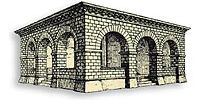 The Venetian Loggia
The Venetian Loggiaan elegant building of the 16th century, that used to be a Venetian gentlemens's
club and today houses the information office of the ministry of culture and a sales point of the archaeological museum.
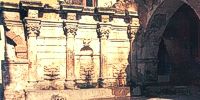 Rimondi fountain
Rimondi fountainwith rich decoration is situated at Platanos square, the centre of the Venetian town. It was built in 1626, by A.Rimondi, in order to provide the citizens with drinkable water.
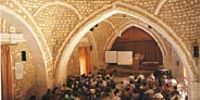 Neratzes mosque
Neratzes mosqueformerly the Holy Virgin church, was converted into a mosque by the Ottomans. Today it is used as a music conservatory. Outstanding elements of this building are the doorframe and the three domes. Next to the mosque there is the impressive minaret, built in 1890.
Kara Mousa Pasa Mosque also a venetian monastery that was turned into mosque by the Turks. Today it is the house of the Restoration Board.
Porta Guora the entrance to the Venetian town is the only remnant of the defensive wall.
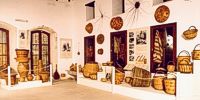 Folklore & history museum
Folklore & history museum(Vernardou 28-30. Open Monday to Friday 09.30-14.30. Closed Saturday and Sunday.) Housed in a restored Venetian building with an interior courtyard. Eight halls with collections that include textile and basket weaving, embroidery & lace, costumes, ceramics, historic photographs and maps, weapons and coins. Over 5.000 items dating from the 17th to the 20th century are displayed.
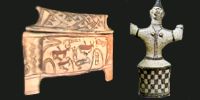 The Archaeological museum
The Archaeological museum of Rethymno
(8am to 3pm, closed on Monday), just opposite the entrance of the fortress, exhibits objects from the Neolithic to the Roman period, found at the prefecture of Rethymno (mainly Eleftherna, Monastiraki and Armeni). Clay figurines, funerary coffers, grave offerings, statues, grave steles, red-figure vases, bronze vessels, jewellery and glass vases, are some of the objects on display.
The Fortezza castle at the top of a low hill named "Palaiokastro" dominates the town. It was built in 1590 to protect the city from the pirates raids and the Turks.
The name "Palaiokastro which means 'The old Castle" was in use even by the Venetians which demonstrates the existance of an even older castle at this place. - Probably the acropolis of the ancient town of
Rithymna.

The interior of Fortezza accommodated the following basic buildings: the storeroom of the artillery, where canons and weapons were kept, the residence of the Councillors, where one of the city's two Venetian councillors lived, the residence of the Rector, which represented a luxurious, magnificent building in the central square of the fortress.
Today parts of those buildings, as well as of some others built later, can be seen. The view from up there is magnificent, especially at night.
The municipal theatre "Erofili" stands also at Fortezza's premises. It is an outdoor theatre that hosts almost all the performances during the Renaissance Festival.
The municipal gardens are ideal for those in search of shade and tranquillity.
Throughout the year various activities are organized which draw a large crowd.
The Wine Festival is held there annually at the beginning of July.
Another festival is held on 7-8th of November, in memory of the destruction of Arkadi Monastery.
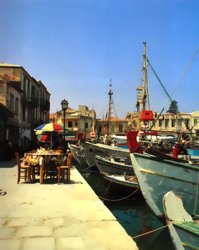
Facilities
Rethimnon is a city that caters to the needs of the visitor.
There are a lot of places to stay ranging from luxury hotels to rent a room, bed and breakfast apartment buildings.
Night life can range from extremely intense on the pubs and bars around the harbor and inside the old city , to relaxed on small bars right on the beach.
There is always fresh fish to be found in the tavernas around the harbor and there
are many other restaurants and tavernas outside
the city in equally attractive surroundings.
Shopping could also be interesting at Rethimno. There are lots of small shops with attractive merchantise from souvenirs, cards, etc to the most rare kind of sponge.
Cultural Life
Apart from enjoying the beaches, excursions into the realm of nature, good food and a drink of raki, the town of Rethymno also offers plenty of entertainment and revelry throughout the year. The most important event constitutes the
Renaissance Festival, which is organised each summer since 1987, in order to revive both the Cretan and the European Renaissance. Most of the events take place in the theatre “Erofili”, which is situated on the hill of the Fortress. To walk on the path, which is paved with cobblestone, uphill to the “Fortezza” on a summer evening and to live the delightful moments of a theatre, dancing or music performance is a blissful experience.
Rethymno Renaissance Festival Video
In winter the town of Rethymno lives in the rhythm of
Carnival. Here, the grandest carnival on the island of Crete is organised. Apart from the great parade on Shrove Sunday, a large number of activities complete the framework of the Carnival festivities. The locals devotedly and cheerfully prepare for this season with creativity, they sacrifice their spare time and become young again while rejoicing and celebrating parties almost on a daily basis. More than 4,000 people have worked feverishly for months in order to present their masks and carriages on the great Carnival parade…The following day, on Shrove Monday people from the countryside play a leading part in the festivities. Unique traditions are revived in the villages and everybody is invited to participate in games, street performances and satires as for example “the kidnapping of the bride”, the “Cadi”, the “smudging of people”. These performances in combination with good wine and the music of the lyre are a successful formula for a unique experience.

Rethymnon Useful Information
Rethymnon Promotion Committee 2831025571-2
Police Emergency 100
Tourist Police 2831028156
Traffic Police 2831022589
Police Department Rethymno 2831025247
Fire Brigade 199
Hospital 2831087100
Dialysis center 2831026093
Health Center: Spili 2832022222
Public Busses 2831022212
Post Office 2831022303
Taxi 2831024316 2831025000
Olympic Airways 2831022257
ANEK (ferries) 2831029846
MINOAN LINES 2831022941
Port Authority 2831022276
Tourist Information (EOT) 28310 29148 – 2831056350
City Council 2831088301
Hotel Association of Rethymno 2831055873
Association of Rural Tourism 2831061689
Mountaineering Club 2831057760
Sailing Club 2831050450
Cycling club 2831051008
Archaeological Museum of Rethymno 2831054668
Historical & Folk Museum 2831023398
Center of Contemporary Arts 2831052530
Centre of Cretan Popular Art 2831051501
Catholic Church 2831026416